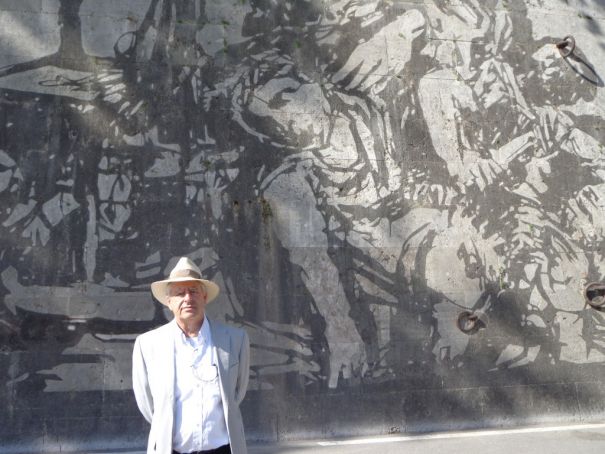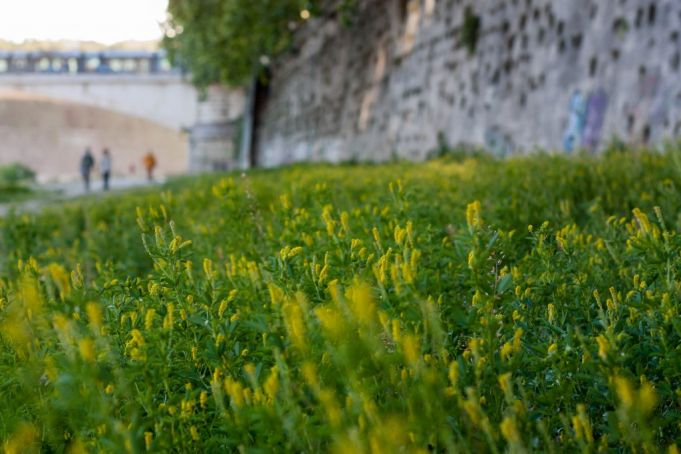William Kentridge triumphs with mural along the river Tiber in Rome.
Andy Devane
“Every country has both a heroic history and a shameful history,” noted the internationally acclaimed South African artist William Kentridge during a press conference in Rome last September. “Someone's triumph is somebody else's lament.” Kentridge was speaking at the MACRO contemporary art museum on Via Nizza during the launch of his monumental mural project, along the banks of the river Tiber, which is already making headlines around the world ahead of its inauguration on 21 April.
Entitled Triumphs and Laments, the 550m-long frieze between Ponte Sisto and Ponte Mazzini was created by power-washing the almost vertical embankment walls to form silhouettes of figures from three millennia of tumultuous Roman history. The unusual process led to the emergence of a procession of some 80 figures, blasted clean through the thick dark patina of the stone walls, an accumulated mixture of fungi and man-made pollution. The technique involved spraying water through huge stencils, based on Kentridge's original charcoal drawings, which were attached to the blackened walls. The resulting grey-brown figures, some as high as 12 metres, are set against the newly white travertine background, enlivened by random flourishes of yellow lichen, nature's unpredictable way of injecting a splash of colour.

Inauguration
Kentridge's grandiose project opens at dusk on 21 April with a theatrical performance of dance, shadow play and music composed especially for the occasion by fellow South African and long-time collaborator Philip Miller. Two dance groups – one symbolising triumph, the other lamentation – will converge against the backdrop of the frieze, their dances interwoven with chants and music by more than 40 musicians and vocalists, with four replications of the event held on 21 and 22 April.
The date of the inauguration is no coincidence – Rome's 2,769th birthday – and neither is the project's central location between the Vatican and the Jewish ghetto district. Kentridge says the epic frieze is placed between “the fortune of the popes” on one side, and “the suffering of the Jewish ghetto” on the other. As an artist of Jewish heritage, Kentridge has particular empathy for the tragedies that befell Rome's Jews who were confined to the tiny ghetto until 1870 and then deported en masse to concentration camps during world war two.

Sorrows and jubilations
The 60-year-old artist from Johannesburg describes his project as “a commentary on the flawed nature of memory, both individual and collective”, with inspiration gained from the Tiber: “a river swollen with glory and pain.” Heralded by its organisers, the non-profit association Tevereterno, as the largest work of art created in Rome since the Sistine Chapel, the procession explores the city’s sorrows and jubilations, traversing through mythology to recent times. Kentridge's sequence of events is not depicted in chronological order, rather it is designed as a way of uniting historic figures from Rome and Italy “for a conversation on the riverbank."
Centurions, legionaries and victorious emperors such as Marcus Aurelius rub shoulders with Roman orator Cicero, fascist dictator Benito Mussolini and the lupa or she-wolf that suckled Romulus and Remus, the legendary founders of Rome. Included too are the murdered bodies of former Italian prime minister Aldo Moro and film director Pier Paolo Pasolini, alongside Marcello Mastroianni kissing Anita Ekberg in the Trevi Fountain scene from the Fellini classic La Dolce Vita. Kentridge also documents the death of 19-year-old student Giorgiana Masi, killed by a stray bullet during a demonstration on nearby Ponte Garibaldi in 1977, while the current migrant crisis off Italy's southern coast is referenced by a Roman slave galley.

Vanishing vision
Ephemerality is central to Kentridge's vanishing vision which “will fade in five to 10 years as the embankment walls gradually turn dark again with pollution, moss and lichen.” The artistic director of Triumphs and Laments is Kristen Jones, the founder and honourary president of Tevereterno. It was Jones who invited Kentridge to consider creating a work for the space; she also devised the silhouette stencil method for the scheme which she describes as both site-specific and “placemaking”. The Piazza Tevere site between the two bridges is poised to become one of Europe's largest public spaces for contemporary art, according to Jones, a long-term Rome resident originally from Washington DC.
Bureaucratic obstacles
However it wasn't all plain sailing for the project which was long delayed in recent years by bureaucratic obstacles from a regional office of the Italian culture ministry. The uncertainty faced by Tevereterno was in spite of the project having the support of the capital and the Lazio region, the verbal support of then culture minister Massimo Bray, and being fully compliant with governmental regulations for the protection of historical monuments. However, thanks to the doggedness of Tevereterno the red tape was overcome with the help of an enthusiastic Giovanna Marinelli – Rome's former culture councillor under Ignazio Marino – and Italy's current culture minister Dario Franceschini.
The fact that Italy came so close to losing out on an art work of this scale by an artist of the calibre of Kentridge was doubly embarrassing – lamentable even – considering that Rome was not required to foot the bill. Triumphs and Laments is privately funded, with the city providing support by supplying the cleaning equipment.
Media blitz
Ahead of the inauguration Kentridge engaged in a blitz of interviews with the media, attending a succession of thronged speaking events and exhibition openings. Dozens of disappointed people were turned away from a talk he gave at the British School at Rome (BSR) on 15 April. With his trademark panama hat, white shirt and pince-nez glasses, Kentridge has a distinguished air about him. In front of audiences he is assured and affable, eloquent and charming. His conversation – particularly in relation to the Tiber project – is peppered with the word “Renaissance”, whose adjective form could be applied to Kentridge himself. His interdisciplinary work bridges visual art, film, opera, theatre and philosophy, while his "ferociously sharp intellect” was noted by BSR director Christopher Smith.

This is the largest artistic endeavour to date by Kentridge who compared the process to unwinding the images from Trajan's Column and “stretching them out like a strip of film.” Although perhaps more impressive and effective when viewed from the opposite bank, it is only when one stands directly below the figures that their sheer immensity becomes evident. There is no doubt regarding the depth of thought, skill, imagination and perseverance behind the work, which has been hailed, justifiably, as a masterpiece. Its composition is measured and balanced, neither too cluttered nor too void; it is both organic and appropriate for its location.
Urban context
The danger with an undertaking such as this, however, is that it “shows up” neighbouring areas, in this case the embankment on the opposite side. Prior to a major volunteer-led clean-up just days before the inauguration, the left bank contained several makeshift campsites, complete with washing lines and impromptu cooking facilities. Pigeons pecked at pots and pans. The buckled pavement was in a wild state, its vegetation fertilised by the rich alluvial mud from winter floods, resembling more an abandoned canal towpath in the countryside than the riverbank of a major European capital. Here too, Kentridge has triggered his magic Renaissance effect.

But for all its dreamlike beauty Triumphs and Laments remains grounded in Rome's gritty urban reality – the steps down to the Tiber, particularly on the Trastevere side – reek of stale urine, the nearby walls are covered in graffiti, smog and weeds. Kentridge acknowledged this juxtaposition to the Italian newspaper La Repubblica, saying: “Above....a pulsating, splendid city; below, under the bridges, the desperation of the homeless."
Art tourism
Already a much-photographed landmark, Kentridge's magnum opus will undoubtedly lead to a surge in art tourism – some of it by boat – in tandem with Rome's burgeoning street art scene. The publicity generated by the project will also help Tevereterno in its worthy quest to rejuvenate the Tiber, a valuable Roman asset neglected for far too long. In the meantime Piazza Tevere's magnificent frieze is shared by a tranquil community of cyclists, joggers, fishermen and ducks, its reflection seized by a river swollen with glory and pain.
Side Notes
TEVERETERNO
Founded in 2004, Tevereterno is led by artists, architects and planners working in parallel with the city to reanimate the Tiber with cultural events. Since 2005 it has overseen public programmes along the river banks by acclaimed international artists such as Jenny Holzer, Steve Reich, Kiki Smith, Roberto Catani and Walter Branchi, website.
MACRO
17 April-2 Oct. William Kentridge: Triumphs and Laments: a project for Rome, an exhibition of more than 80 works in charcoal, pastel and ink, as well as cut-outs and videos, which led to the project's final designs. Via Nizza 138, website.
TIBER EMBANKMENTS
One of the largest public works programmes ever undertaken in Rome, started by Garibaldi to save the city from the usually devastating spring and autumn flooding. Commemorative plaques in the city centre, especially around the Pantheon and Piazza Navona, indicate the level of the 1870 floods.

















